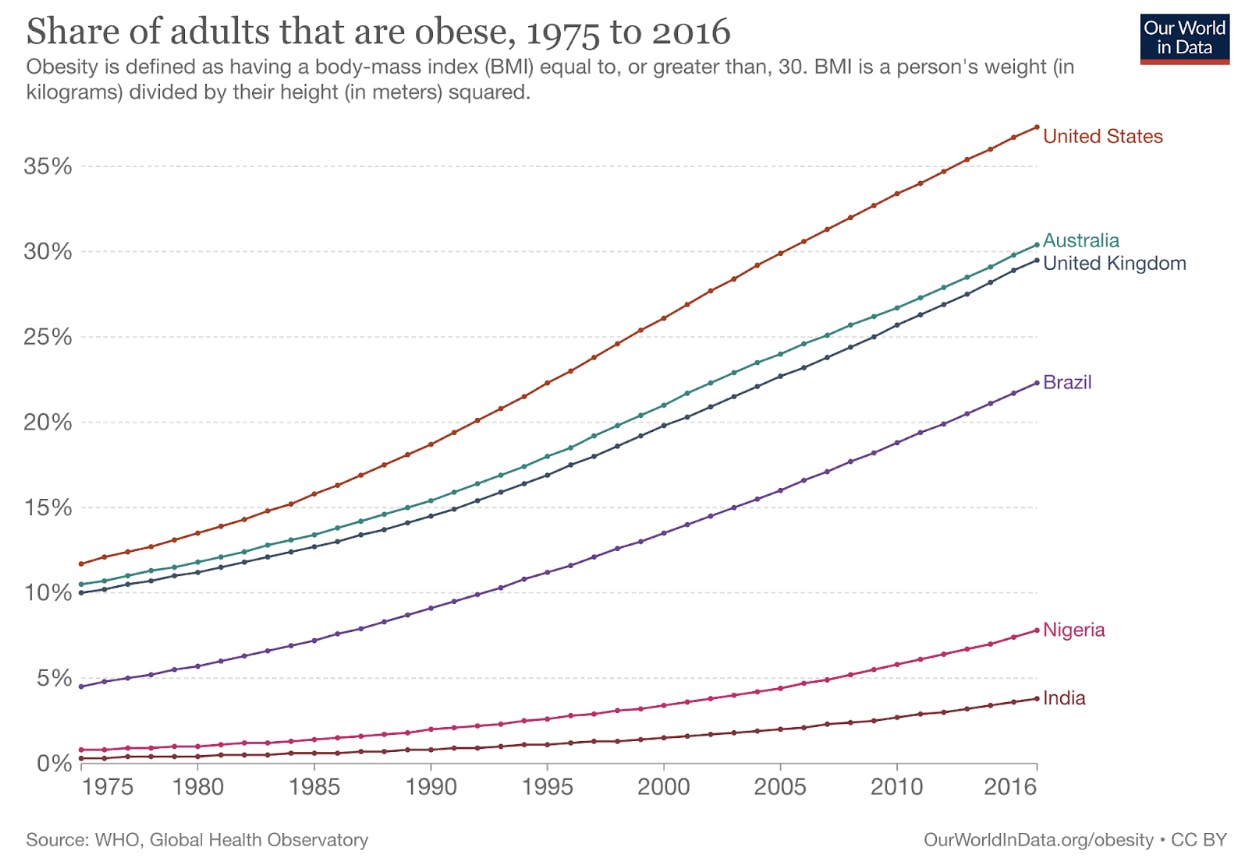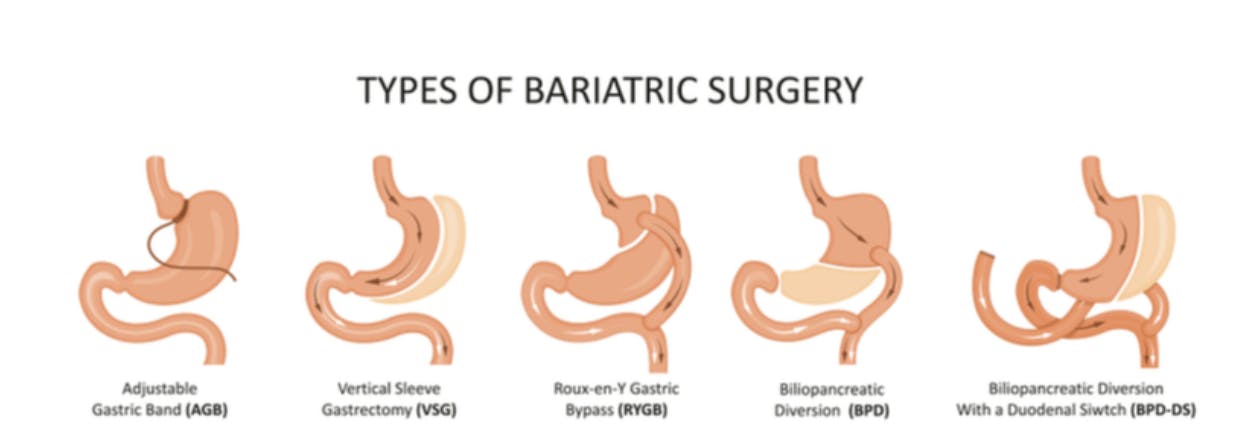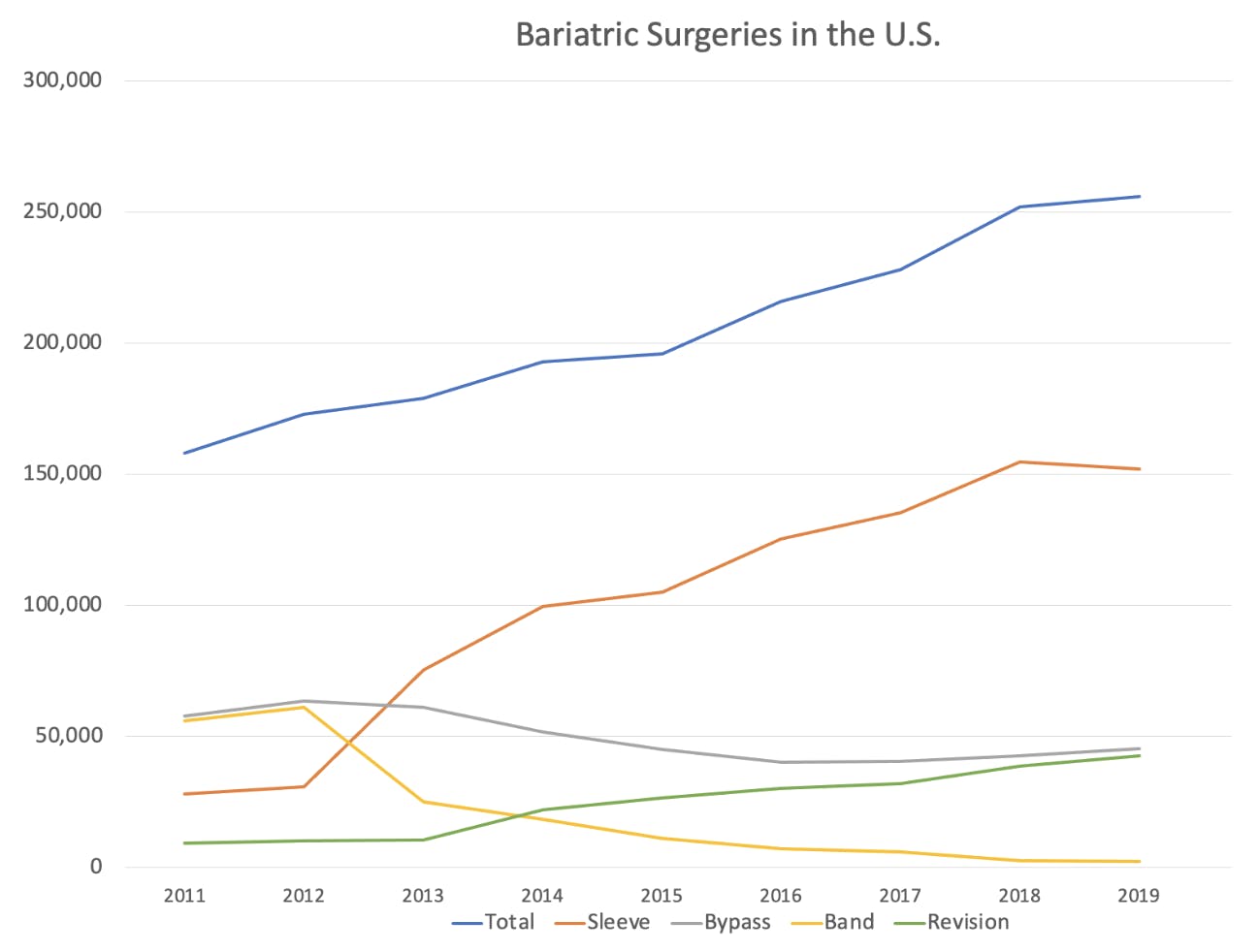TL;DR Science: Bariatric Surgery
By Thomas P.
May 12, 2022 · 4 minute read
Biology
Medicine
Not medical advice. Merely for the purpose of conveying curious inquiry.
More than 1-in-3 adults in the World are obese, about 39%. The average weight of the US adult has a BMI* of 26.5-26.6 depending on sex which is higher than the healthy BMI for adults of 25. It is painfully evident that obesity is an epidemic in the United States and across other developed countries. Since obesity is known to be the cause of a reduced life expectancy and a higher risk of cardiovascular disease, it is no wonder that the average life expectancy has declined slightly in our country.

The typical solution to reducing weight is through exercise and eating healthier foods, however this is not typically an option that is open to individuals with very high BMI because significant weight loss via those paths may be very difficult. In addition, most of the time, it is not a problem of lack of exercise, but an imbalance between energy consumed (food consumed) and energy expended (exercise). In order to reduce the amount of food consumed, surgeons can perform different kinds of procedures to reduce the size of the stomach or bypass it all together.
Bariatric surgeries can have numerous benefits and detriments. The obvious benefits are that they reduce comorbidities associated with obesity, and allow for people to live longer. The detriments often include complications of the surgeries; internal bleeding, nutrient deficiencies, anxiety, a need for further surgery to revise (change) the previous surgery, etc.

Gastric** sleeve procedure
The Gastric sleeve procedure is where the surgeon takes out a huge portion of the stomach of the patient (70-85% of it) and staples it shut; the stomach is thus transformed from a pouch to a sleeve. The gastric sleeve procedure is the most common bariatric procedure, and the simplest, given it only requires reducing the size of the stomach, which eventually will reduce the amount of food consumed. The patient is put on a diet of eating liquid and soft foods, such as soup, and then can return to a relatively normal diet at reduced capacity.
A Bilopancreatic diversion with a duodenal switch (BPD-DS) is a different procedure that uses the gastric sleeve procedure, but adds two other steps. With this procedure, the majority of the small intestine is bypassed to connect the upper small intestine (duodenum) with the lower small intestine (jejunum); this is the duodenal switch. The biliopancreatic diversion is where the surgeon connects the rest of the intestine that was bypassed to the stomach in order to store digestive juices. The procedure carries more risks than the sleeve procedure, though.
Gastric bypass procedure
The Gastric bypass procedure is another procedure that helps reduce weight; however, it does so to a more severe degree. In the Gastric bypass, the surgeon divides the stomach using staples into a lower part and much smaller upper part. The upper section is then connected to the jejunum, bypassing the stomach and duodenum. The result is a stomach size >96% smaller than its initial size. In addition, because the stomach is so drastically reduced in size, a person can only eat approximately 5-8 oz at time, which pales in comparison to the diet following the sleeve procedure. As a result, the bypass can drastically reduce a person’s weight. Yet, the procedure does come with numerous possible complications: internal bleeding and nutrient deficiencies.
Gastric band
The final type of bariatric surgery is the Gastric band. This type of surgery involves the insertion of a band that constricts the upper half of the stomach to create a smaller pouch in order to decrease food consumption, much like the Gastric bypass. However, this procedure carries some decreased risks compared to the bypass procedure, especially given it does not require staples or an intestinal re-routal. As such the procedure is also less drastic in its effects on patients. A potential risk of the gastric band procedure, though, is that it may require a revision if the band malfunctions.
A look at bariatric surgery trends in the U.S.
The number of bariatric surgeries in the U.S. has continued to rise, with the continually rising average BMI of the U.S. The Gastric Sleeve procedure has taken a larger share of bariatric surgeries performed in recent years, with the Gastric Bypass’ share of surgeries performed declining. The Gastric band procedure has also seen its share of surgeries performed decline in years of late, similar to the bypass, but much more drastically. As a result of a continued rise in bariatric surgeries, revisions have been continually rising.

Source: https://asmbs.org/resources/estimate-of-bariatric-surgery-numbers, graph created in Excel by Thomas P.
Footnotes
* Body mass index; a measure of body mass (weight) relative to a person's height. Formula:

** Of or relating to the stomach.
References
https://en.wikipedia.org/wiki/Gastric_bypass_surgery
https://renewbariatrics.com/bariatric-surgery-statistics/
https://asmbs.org/resources/estimate-of-bariatric-surgery-numbers
https://en.wikipedia.org/wiki/Sleeve_gastrectomy
https://www.webmd.com/diet/obesity/what-is-gastric-sleeve-weight-loss-surgery
https://www.medicalnewstoday.com/articles/298313#risks
https://en.wikipedia.org/wiki/Adjustable_gastric_band#Working_principle
Did you enjoy this article?
About The Author
Thomas is a student at Eastside High School.